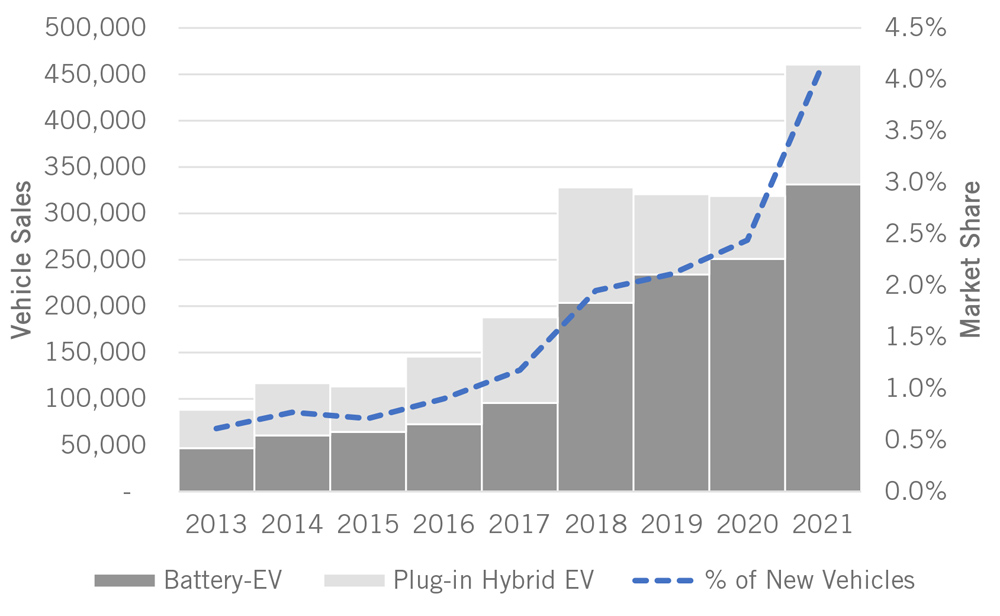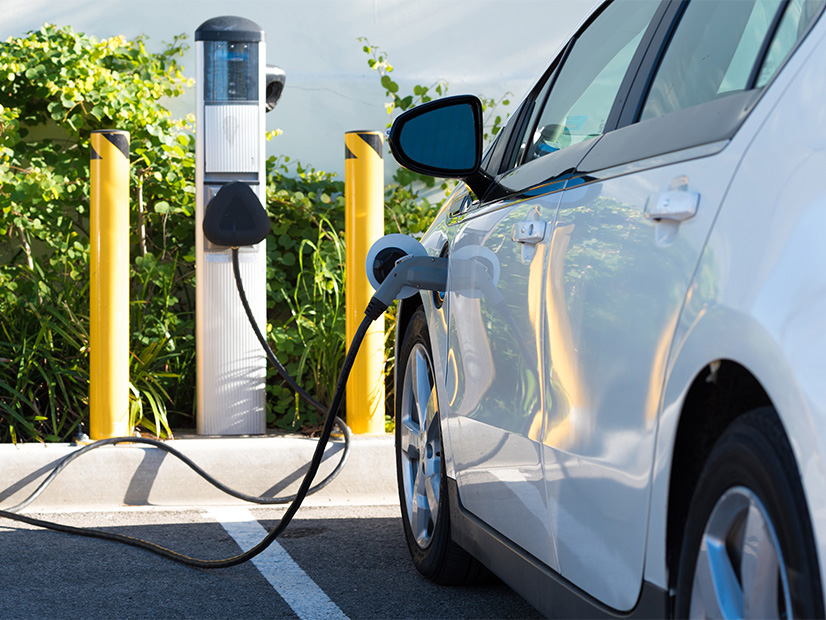New Jersey could encourage greater use of electric vehicles in overburdened communities by creating larger purchase incentives, targeted incentives for used vehicles and EV-based ride-sharing plans, according to a draft report by the state’s Board of Public Utilities (BPU).
As EV use and charging stations become more widespread, communities that suffer most from heavy emissions face particular challenges to reaping the benefits of clean vehicles, according to the “New Jersey Overburdened Communities Electric Vehicle Affordability Program Study,” released July 19.
The challenges include EVs’ high price tag, the difficulty of owning any type of vehicle in those communities due to parking and other limitations, and the obstacles to installing chargers that serve multi-unit dwelling units (MUDs), which house about 36% of New Jersey’s population and are especially prevalent in low-income areas.
The report suggests counteracting those obstacles by ensuring a greater density of direct current fast chargers in overburdened communities, which would require more consistent funding of incentives to install chargers around MUDs. EV uptake also could be stimulated through incentives encouraging ride-share drivers to install Level 2 chargers in their homes and providing them with an “advantageous rate” for electricity.
The report’s perspective aligns with a similar assessment released in June by the Information Technology Innovation Foundation, which concluded that a broader uptake of EVs, especially in low-income and minority communities, will be needed if the U.S. is going to reach its ambitious clean energy transportation goals.
“Conventional approaches that encourage adoption of this early stage technology are primarily reaching a distinct group of higher-income individuals,” said the foundation’s report, “Clean and Just: Electric Vehicle Innovation to Accelerate More Equitable Early Adoption.”
EVs accounted for about 4% of U.S. vehicle purchases in 2021, the report says, and “research shows that early adopters tend to be higher-income, well-educated, and predisposed to environmentally friendly technologies.”
But a much broader driving demographic will be needed to reach the target of having EVs account for 60% of new car sales by 2030, and that will require new motivational strategies, the report said.
 Electric vehicles made up 4% of new vehicle sales in the U.S. in 2021. | Information Technology and Innovation Foundation
Electric vehicles made up 4% of new vehicle sales in the U.S. in 2021. | Information Technology and Innovation Foundation
“Conventional approaches to encourage the purchase of EVs may fail to reach low-income and disadvantaged communities,” the report said. “Because these groups face distinct challenges in adopting the technology.”
In contrast, by “intentionally including a diverse range of users early in the adoption process, technology providers can more effectively identify issues and modify the technology to successfully appeal to a mass market,” the report concludes.
New Jersey officials have already recognized that dynamic on a small scale. The BPU, for example, changed the incentive strategy in its Charge Up New Jersey program after 83% of incentives in the first phase went to purchasers of Tesla vehicles, which are among the most expensive EVs.
The agency in the second phase allowed purchasers to get the maximum incentive — at the time $5,000 and now reduced to $4,000 — only if they bought a vehicle with a price tag of no more than $45,000, which allowed for only the lowest-priced Tesla model. (See NJ EV Incentives Target Cheaper Vehicles, Middle-income Buyers.)
Lawmakers also recognized the need to put EVs in urban areas in a bill signed Thursday by New Jersey Gov. Phil Murphy. The law allocates $45 million to a three-year pilot program that will test electric school buses and related charging stations in 18 school districts around the state.
Half the funding will go to EV buses for low-income, urban or environmental justice communities in order to mitigate the disproportionate health impacts of medium- and heavy-duty vehicles on vulnerable populations. (See Electric School Bus Pilot Awaits NJ Governor’s Signature.)
Priorities in Cutting Emissions
Maria Lopez Nunez, deputy director of organizing and advocacy for the Ironbound Community Corporation, is skeptical that focusing on introducing EVs is an effective way to reduce emissions in disadvantaged communities, especially given the obstacles to EV ownership in those areas.
Such a strategy is simply putting a “Band-Aid” on the problem, said Lopez Nunez, who lives in Newark, one of the state’s most disadvantaged communities and one of those analyzed in the report. She said she is not sure if she was consulted by the report’s researchers, but she has expressed her views to state officials several times on the kind of issues it raises.
“It’s treating a symptom, not the root cause here,” she said. “When we’re talking about personal vehicles, you know, you’re talking about something that’s really inaccessible for communities like mine, where up to 40% of people don’t have a car. So, they’re not going to get a car now that it’s electric. That’s out of reach for most folks.”
The key polluters in the community are heavy-duty trucks and fossil fuel plants, she said. So, electrifying heavy trucks and shutting down the plants would have a much greater impact, she said.
“This is meant to help middle-class New Jersey, who want to transition [to EVs] and that’s OK,” she said, of the proposals outlined in the BPU’s report. “But let’s not pretend that it’s helping overburden communities.”
Locating Charger Sites
The BPU compiled the report with funds from the U.S. Department of Energy’s Office of Energy Efficiency and Renewable Energy. Although the work was conducted by its own staff, the BPU says that it has not yet taken a position on the plans outlined in the report.
New Jersey defines overburdened communities as any census block in which at least 35% of the households qualify as low-income; at least 40% of residents are minorities; or at least 40% of households have limited English proficiency. They account for about 4.7 million people, or slightly more than half the population of the state.
To compile the report, researchers reached out to three overburdened communities in the state — Newark, New Brunswick and Washington Township — and talked to local government representatives, community group leaders, and industry experts. The researchers paid particular attention to cities in which EV infrastructure is insufficient to enable drivers to own an EV with the “same level of ease” as people who can charge it at their own residence. The report also focused on “transportation deserts,” where access to public transportation is limited, and areas with multi-unit dwellings.
Those communities find it especially difficult to adopt EVs due to the high upfront cost and lack of used EVs for sale, the report said. Disadvantaged residents also may lack access to financial tools, such as checking accounts or credit cards, smartphones or the internet, which are needed to connect to charging networks or to identify available charging services.
The existing lack of available parking also weighs heavily on efforts to get EVs into those communities, according to the report. It quoted a Newark government official saying the city was particularly hampered in introducing EVs because the city “does not have enough public lots in high traffic areas to build out sufficient EV charging infrastructure.”
That puts the emphasis on making sure that multi-dwelling units have parking and charging infrastructure, the report said. The report suggested that the problem could be remedied by developing “neighborhood charging lots,” where residents could charge overnight and “start their day with a full charge.”
The lack of parking and obstacles to personal vehicle ownership underscore the importance of ride-hailing services, the report said. Such services can negate the need for personal vehicles in cities and can be more economic for users because the relatively short trip lengths mean the ride is not too expensive, the report said.
EV Promoting Private Initiatives
The Information Technology Innovation Foundation report concludes that “innovation is a key strategy to both addressing disparities in EV adoption and aiding the broader goal of mass adoption.”
Madeline Yozwiak, a doctoral student at Indiana University Bloomington and one of the authors of the report, said one difficulty to be overcome before overburdened communities can embrace EVs is to adjust the federal incentive system. The main federal incentive available at present is a $7,500 tax credit, but many people in those communities don’t earn enough to pay that amount of taxes, and so can’t take all of the credit, she said during a July 26 webinar on the report.
She said that range anxiety, an issue in all communities, can be heightened in low-income communities.
“For example, if you’re traveling longer if you live further from where you work due to the cost of housing closer to your place of employment,” she said. “Or if you’re an individual in a rural community where your average trip tends to be longer than someone who lives in a denser region of the country.”
Yozwiak and the report identified several innovators that are seeking to address some of the obstacles, including:
- SparkCharge, a company that offers a subscription service in which the company will bring mobile battery chargers to charge the subscriber’s car.
- Recurrent Energy, which, according to the report, “uses data monitoring of existing EVs to create used-EV purchase reports, which can decrease purchase barriers for affordable, used vehicles.”
- Sway Mobility, which develops “micro” car-sharing programs, as small as one vehicle, for partner organizations working in marginalized communities. That can decrease the cost of creating a car-sharing program, the report says.



